#Stefan Kaegi
Explore tagged Tumblr posts
Text




2024–10–22 ~ 23 아르코예술극장
리미니 프로토콜, 이것은 대사관이 아니다
리미니 프로토콜, 이것은 대사관이 아니다 (This is not an Embassy), 콘셉트/연출: 슈테판 카에기(Stefan Kaegi), 출연: 데비 수야 왕, 데이비드 우, 치아요 쿠오, 드라마 트루기/조연출: 웬 스니, 무대디자인: 도미닉 후버, 영상: 비에른 미코 게스텔, 음악: 폴리나 랩콥스카자 (폴리에스터), 데비 수야 왕, 헤이코 튜브싱, 리서처: 로 잉루, 영상촬영: 필립 린, 조명: 피에르-니콜라스 물랭, 공동 드라마투르기: 캐롤라인 바노, 조연출: 킴 크로프트, 무대디자이너: 지원 마티유 스테판, 퍼스트 네이션 대표: 캉라-라혹, 영상 안무: 하나 아줄라, 자문: 알요샤 베그리치, 비비안 파빌롱, 장소: 아르코예술극장 대극장, 2024년 10월 22~23일 (20:00), 입장료: 60,000월(R석), 40,000원(S석), 예매: via Interpark, via ARKO.
1 note
·
View note
Video
vimeo
Spiegelneuronen Trailer // Stefan Kaegi from Rimini Protokoll on Vimeo.
Spiegelneuronen
Ein dokumentarischer Tanzabend mit Publikum
Von Stefan Kaegi / Sascha Waltz & Guests
Dieses Stück ist ein Experiment. In jeder Aufführung von neuem. Es geht um das menschliche Gehirn und sein Verhältnis zum Körper. Das Publikum ist ein wesentlicher Teil des Experiments, denn es ist eingeladen, nicht nur Tanz zu beobachten, sondern sich auch selbst zu bewegen, von seinem Sitzplatz aus als aktiver Teil eines gemeinsamen Systems zu agieren, sich selbst als Teil einer Art großen Gehirns zu erleben.
Spiegelneuronen ist die erste Zusammenarbeit mit Sasha Waltz & Guests. Damit setzt die Tanzcompagnie die Öffnung für neue Handschriften sowie ihr Interesse an künstlerischer Recherche und genreübergreifender Zusammenarbeit mit internationalen Künstler*innen zur Erweiterung ihres Repertoires fort. Aus sehr unterschiedlichen Richtungen kommend, interessieren sich beide Compagnien für die ungewöhnliche Bespielung von Räumen sowie die interdisziplinäre Arbeit. Nun untersucht Stefan Kaegi gemeinsam mit Tänzer*innen von Sasha Waltz & Guests sowie dem Publikum das Verhältnis zwischen Individuum und Gesellschaft mit den Mitteln des Tanzes vor einem großen Spiegel.
Spiegel haben in Ballettproberäumen eine lange Tradition. Historisch hatten sie dort vor allem eine normative Funktion, dienten sie doch der Perfektionierung des Corps de Ballet, einem durch Disziplin und Drill synchronisierten Gesamtkörper aus einem ganzen Chor von Tänzer*innen. Kein Wunder, dass dieser Spiegel parallel zum Aufstieg des Individuums und der subjektiven Freiheit im modernen und zeitgenössischen Tanz an Bedeutung verlor. Dieser dokumentarische Tanzabend richtet den Spiegel nun auf das Publikum zurück und bezieht es als Subjekt der Betrachtung ins Experiment mit ein.
Ein Spiegel wird in diesem Abend da installiert, wo normalerweise die Bühne ist. Er reflektiert nicht nur die Tänzer*innen, sondern wie ein gigantisches Selfie die ganze Tribüne mitsamt dem Publikum. So wird, ähnlich wie bei Aktionen des Performancekünstlers Dan Graham in den 1970er-Jahren, der Zuschauerraum zum Hauptaktionsort. Das Publikum rückt im Austausch mit den Tänzer*innen selbst ins Zentrum der choreografischen Bewegungen und erlebt sich beim „Verkörpern“ von komplexen Bildern.
Neurowissenschaftler*innen gehen davon aus, dass unser Nervensystem nicht zentral gesteuert ist, sondern dass die verschiedenen Bereiche des Gehirns intensiv miteinander kommunizieren: vergleichbar einem Computernetzwerk mit Algorithmen, die nicht linear, sondern dezentral agieren und auf ihren Kontext reagieren, während sie Informationen sammeln und prozessieren. Wie genau das geschieht, darüber kann auch die Wissenschaft bisher nur spekulieren. Immer wieder werden neue Mechanismen entdeckt. Anfang der 1990er-Jahre zum Beispiel die Spiegelneuronen: Diese führen dazu, dass das Gehirn in ähnlicher Weise angeregt wird, egal ob wir selbst etwas tun oder dieselbe Handlung bei einer anderen Person beobachten. Obwohl beim Menschen schwer nachzuweisen, könnten Spiegelneuronen einen Schlüssel zur Erklärung von Empathie und gegenseitigem Verstehen darstellen.
Die dokumentarische Recherche zu diesem Tanzabend bezieht Konzepte aus Hirnforschung, Biologie, Soziologie und künstlicher Intelligenz ein, die das Publikum einerseits hört und reflektiert und andererseits erlebt, nachvollzieht – vielleicht sogar antizipiert oder versucht, sich ihnen zu entziehen. Und zwar ganz konkret am eigenen Körper und als große Gemeinschaft im Publikum. Über den Spiegel betrachten die Zuschauer*innen sich und die anderen beim Beobachten des Versuchs, in dessen Zentrum sie sitzen.
Modellhaft lässt sich mittels Bewegungsimpulsen eine Gruppe von Menschen auf einer Tribüne ähnlich vernetzen wie ein Gehirn. Vertont wird dieses bewegte Bild durch ein Musikarrangement mit O-Ton-Einspielungen von Wahrnehmungsforscher*innen. In der Wahrnehmung des Publikums verwebt sich die Szenerie mit deren Gedanken, illustriert oder konterkariert sie, vervollständigt oder widerlegt sie. Jeden Abend anders.
Konzept und Regie: Stefan Kaegi Musik: Tobias Koch Bühne: Dominic Huber Video: Mikko Gaestel Dramaturgie: Silke Bake Tänzer*innen: Melissa Kieffer, Dominique McDougal, Orlando Rodriguez, László Sandig, Claudia de Serpa Soares, Wibke Storkan u. a. Eine Produktion von Sasha Waltz & Guests in Zusammenarbeit mit Rimini Protokoll. Eine Koproduktion mit den Salzburger Festspielen, Tanz Köln, Kampnagel - Internationales Zentrum für Schönere Künste
0 notes
Text
vimeo
How can we approach the landscape without distancing ourselves at the same time? What if art did not imitate nature, but allowed us to experience it? Caroline Barneaud (Théâtre Vidy-Lausanne) and Stefan Kaegi invite their audience to leave the theatre and venture out into Berlin’s green surroundings. From early afternoon to sunset, seven productions by European artists will address the (re-)discovery of landscape. What relationships can we build, which established perspectives can we alter? Under the open sky, artistic interventions, performances, sound compositions, choreographies, media art and theatre will create a fleeting moment of a new kind of community as a performative response to the land art movement of the visual arts. With productions by: Chiara Bersani and Marco D’Agostin (Italy) El Conde de Torrefiel (Spain) Sofia Dias and Vítor Roriz (Portugal) Begüm Erciyas and Daniel Kötter (Turkey, Belgium, Germany) Stefan Kaegi (Germany, Switzerland) Ari Benjamin Meyers (Germany) Émilie Rousset (France) Concept and curation: Caroline Barneaud, Stefan Kaegi Artistic assistant: Giulia Rumasuglia Stage manager: Guillaume Zemor Production and coordination: Isabelle Campiche, Aline Fuchs (Théâtre Vidy-Lausanne) With the support of the production, technique, communication and administration teams of Théâtre Vidy-Lausanne Coordination of Performing landscape Rimini Protokoll: Chloé Ferro, Monica Ferrari, Lara Fischer Production: Rimini Apparat and Théâtre Vidy-Lausanne (Switzerland) Co-production: Performing landscape, European consortium: Bunker and Mladi Levi Festival (Slovenia), Culturgest (Portugal), Festival d’Avignon (France), Tangente St. Pölten – Festival für Gegenwartskultur (Austria), Temporada Alta (Spain), Zona K and Piccolo Teatro di Milano Teatro d’Europa (Italy). And Berliner Festspiele (Germany). Co-funded by the European Union. The concept creation was funded by the Federal Agency for Civic Education. With the support of INVR Berlin for the virtual reality headsets.
0 notes
Text
0 notes
Text
Rimini Protokoll presenta en Naves del Español 'Conferencia de los ausentes'
Rimini Protokoll presenta en Naves del Español ‘Conferencia de los ausentes’
La Sala Fernando Arrabal de Naves del Español en Matadero presenta del 8 al 10 de octubre el espectáculo Conferencia de los ausentes, del colectivo artístico alemán Rimini Protokoll, integrado por los creadores Helgard Haug, Stefan Kaegi y Daniel Wetzel. Se trata de un montaje en torno al concepto de la globalización en el que, como viene siendo habitual en la compañía, el público es parte activa…

View On WordPress
1 note
·
View note
Text
“Insan Bir Yapay Zeka Midir?”
Notlarim
Etkinlik: “Insan Bir Yapay Zeka Midir?”
Konusmaci: Dr. Umut Eldem
Organizasyon: FelsefeLab/Beykoz Kundura
Tarih: 28 Ocak 2021
Yapay zeka, kisinin yuzunden siyasi gorusunu %72 basari orani ile tespit edebiliyor.
Tuketim kulturu, insanlari olcmeye ve onlari kontrol etmeye ihtiyac duyar. Insan, kontrol edilmeye musait bir varlik midir? Teknoloji, insani donusturuyor mu?
Insan zekasi, spontane ogrenir. Sonsuz cesitlilikte eylemi gerceklestirebilir.
Fransiz felsefeci Pierre Levy, yapay zekanin insan zekasindan bagimsiz olamayacagini soyler. Levy’e gore yapay zeka, insanin ancak bir uzantisi ya da araci olabilir.
Donusturme/Indirgeme
Goruntu, ses, hafiza baska mecralara aktarilabiliyor. Isidan harekete, hareketten elektrige donusum. Zeka da bu sekilde donusturulebilir mi?
Insana ozgu bilissel yetiler ve yargi gucu, kodlanabilir mi? (Kant’a gore yargi gucu, ogretilemez. Formel kurallara ya da algoritmalara, kodlara indirgenemez. Indirgenebiliyor olsa idi hangi durumlarda uygulanabileceginin de kurallari olmaliydi.)
Ozgur irade bir yanilsama midir? Irade, baska bir varlikta ortaya cikabilir mi? Insan, bir karar aldiktan sonra bu kararinin farkina varir.
Yetilerin makineye aktarimi.
Dreyfus’un Itirazi (Heidegger felsefesi)
Insan deneyimine dair ozel durumlari kodlamak mumkun degildir. (Dreyfus)
Insan davranisi ve dusuncesi, bir makine tarafindan manipule edilebilir mi? Bu sekilde kodlanabilir mi?
Deneyimin ve alginin otesinde olgular, bir makina tarafindan uretilebilir mi?
Searle: Cince Odasi Deneyi
Derrida: Makina ve Tekillik (1950s)
Gelecegin dusuncesi. ‘Olgu’ dusuncesi ile makina dusuncesi birlestirilebilir mi?
Stefan Kaegi - Thomas Melle - “Tekinsiz Vadi”
1 note
·
View note
Text
Weekday Pick #37: The Art of Civil Action

It’s election season in Vancouver! Get back in the civic-minded game and brush up with some reading from Valiz: The Art of Civil Action: Political Space and Cultural Dissent, edited by Philipp Dietachmair and Pascal Gielen.
Contributors include Andrew Barnett, Llorenç Bonet, llya Budraitskis, Giuliana Ciancio, Philipp Dietachmair, Milena Dragićević Šešić, Pascal Gielen, Max Haiven, Stefan Kaegi, Ivan Krastev, Thijs Lijster, Tomislav Medak, Borka Pavićević, Yudhishthir Raj Isar, Igor Stokfiszewski, and Hakan Topal.
How do the arts contribute to the formation of democratic processes? How does culture constitute public space and a civil domain? The Art of Civil Action argues that cultural initiatives play an underappreciated but crucial role in unlocking dormant democratic potential in our societies. Arts and culture can be a cornerstone of the civil domain, and an anchor as communities reconcile their local and global identities and roles.
The Art of Civil Action considers how to establish a sustainable, transnational civil space, and what role culture and the arts can play in this process, through a colorful mix of case studies on citizen-led cultural initiatives from around the world. Social scientists, cultural theorists, activists and artists contribute conceptual perspectives on how the arts and culture can help build a locally rooted civil society in a globally connected context.
$33, softcover
10 notes
·
View notes
Video
vimeo
Utopolis Lausanne, une proposition déambulatoire de Helgard Haug, Stefan Kaegi et Daniel Wetzel (Rimini Protokoll) à découvrir du 13 mai au 14 juin 2022 à Lausanne.
Une amie, qui a participé à l’expérience, m’a longuement parlé de la force du projet. Par groupe de 10 ils marchent dans la ville et reçoivent des instructions. Ces instructions sont sous la forme de SMS, billets, carnets. Ce qui l’a le plus touché est lorsqu’il a été demandé au participants de former une ligne sur une place. Le deuxième fait marquant est lorsqu’ils ont dû tous parler de plus en plus fort dans un café pour observer le changement d’ambiance.
0 notes
Photo

VOLKSTHEATER BLACK BOX von STEFAN KAEGI // RIMINI PROTOKOLL Regie STEFAN KAEGI // RIMINI PROTOKOLL PHANTOMTHEATER FÜR 1 PERSON ab 20. Februar 2021 Audiowalk durch die Räumlichkeiten des frisch sanierten Volkstheaters Termine: Samstag, 20.2.2021 | ab 13 Uhr Ausverkauft 21. 02. 2021 | ab 11 Uhr 27. 02. 2021 | ab 13 Uhr 28. 02. 2021 | ab 11 Uhr jeweils alle 5 Minuten für eine*n Besucher*in, Dauer ca. 90 Minuten Arthur-Schnitzler-Platz 1, 1070 Wien https://www.volkstheater.at/stueck/blackbox/ https://estherartnewsletters.com/2021/02/15/vot_black (hier: Volkstheater Wien) https://www.instagram.com/p/CLhR85Nlt0a/?igshid=1e5xyyh3fxu11
0 notes
Photo

#Repost @worldeconomicforum ・ ・ ・ Un robot che somiglia al drammaturgo tedesco Thomas Melle durante un'esibizione di "Uncanny Valley" di Stefan Kaegi al Festival Internazionale del Teatro di Santiago a Mil a Santiago del Cile. Uncanny Valley si riferisce alle somiglianze tra robot e umani. Kaegi esplora questo nel suo lavoro dopo che Melle ha permesso di creare un doppio animatronico di se stesso, ponendo domande sulla rilevanza di un originale quando una replica robotica sarà sufficiente. #robot #robotica #tecnologia #innovazione #futuro REUTERS / Ivan Alvarado https://www.instagram.com/p/CJ6igSvBaiK/?igshid=76x84k5s0t8v
0 notes
Photo

Stefan Kaegi, nel ventre del teatro
Azione, Cultura e spettacoli, 27.07.2020
https://www.azione.ch/cultura/dettaglio/articolo/nel-ventre-del-teatro.html
0 notes
Text
Rimini Protokoll vers un nouveau Théâtre interactif

Rimini Protokoll est un collectif théâtral allemand composé de Helgard Haug, Stefan Kaegi et Daniel Wetzel. Ils se sont tous trois rencontrés dans les années 90 au cours de leur formation à l’Institut des Sciences théâtrales appliquées de Giessen, école reconnue dans le monde du théâtre avant-gardiste.
Pour résumer leur présentation sur leur site web: le trio puise son inspiration dans la réalité et son lien indissociable avec la fiction. Leurs projets sont construits à partir de recherches précises, développés à partir de situations existantes dans le lieu original. Rimini Protokoll travaille toujours, pour ses mises en scène, avec des amateurs, trouvés au cours des recherches, et qui se présentent ensuite dans les spectacles, tels qu’ils sont.
Il s’agit de percer le complexe, qu’est notre réalité, de le montrer sous toutes ses facettes, de manière à pouvoir ainsi le questionner.
Pour illustrer se principe fondateur de leur théâtre, je vais me concentrer sur une œuvre du trio qui symbolise, à mes yeux, toutes l’ingéniosité et la nouvelle portée de leur théâtre interactif. Situation Rooms projet inspiré par la, on ne peut plus célèbre, photo ci-dessous.

The Situation Room montre l’ancien président des États-Unis Barack Obama, au côté de l'équipe de sécurité nationale, recevant les informations en direct de l'opération Neptune's Spear qui conduisit à la mort d'Oussama ben Laden. Pour Rimini Protokoll c’est la fin de la plus grande chasse à l’homme jusqu’à présent. Cette dernière ayant nécessité toutes les armes possibles.

Situation Rooms se déroule dans un série de pièces, ou une vingtaine de spectateurs chacun muni d’un casque et d’une tablette, interagissent entre eux et leur environnement. Chaque spectateur incarne un personnage à travers la tablette tel qu’un tireur d’élite, un militant pour la paix, un photographe de guerre, un chirurgien pour Médecin Sans Frontière, un réfugié syrien, etc...

Chaque rôle est basé sur un ou plusieurs témoignages de personnes réelles. La tablette permet l’affichage d’informations ou de reproductions d’action. Comme la liste des rôles le laisse sous-entendre, ce spectacle interactif est une critique acerbe des guerres au Moyen Orient par des pays sur-développés, de la vente d’arme et de la déresponsabilisation des acteurs dans ces conflits. Deux rôles liés illustrent cette démarche: le spectateur prend tour à tour le rôle d’un lieutenant et d’un conducteur de drone.
Lorsque le spectateur incarne le lieutenant, il lui est seulement demandé, à travers le casque, d’aller dans une salle et de lever le pouce à la personne présente dans la salle. Le spectateur s’occupant des drones a, quant à lui ,comme seul objectif d’attendre le feu vert pour lâcher une bombe sur un village syrien.

Au travers d’un système ludique, interactif et simple le collectif Rimini Protokoll nous fait expérimenter plusieurs choses. Cette réalité bien là, mais souvent déformée, simplifiée voir oubliée est bien réelle et dure. Cette distanciation avec laquelle joue le système de Situation Rooms permet non pas une déresponsabilisation et une déshumanisation mais un recul critique sur une situation déplorable depuis maintenant plus de 50 ans...
0 notes
Text
Eco-Visionaries, Royal Academy
David told me about the exhibition Eco-Visionaries at the Royal Academy, from climate change to species extinction to resource depletion, this exhibit examines the damaging effects that humans have on the environment and the planet. Ranging from work to film, photography, installation, and architectural models. The life of planet Earth and its now endangered ecosystem falls on us, artists involved in this exhibition have attempted to shed light on these devastating issues. Artists including Olafur Eliasson, Ant Farm, Alexandra Daisy Ginsberg, Andrés Jaque, Tue Greenfort, Unknown Fields, Rimini Protokoll, Virgil Abloh and WORKac, and others.
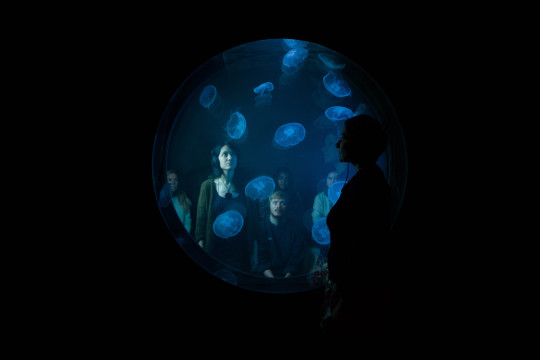
win > < win, (2017), Rimini Protokoll
Rimini Protokoll collaborated with marine biologists and animals’ keepers to create the installation win > < win. Helgard Haug, Stefan Kaegi, and Daniel Wetzel wrote of how almost everything that damages our ecosystem, benefits jellyfish in this article https://www.rimini-protokoll.de/website/en/project/win-win
“Overfishing brings down the number of predatory fish that could reduce the number of jellyfish. Plastic bags in the oceans kill other predators like turtles. On top of that, jellyfish flourish in warm water; it extends their breeding season, while many fish suffer from the lower oxygen percentage. ‘Warm water is a disaster for anything that breathes, and a dream come true for anything that doesn’t breathe much, like jellyfish’” says Lisa-Ann Gershwin, an Australian marine biologist and jellyfish expert. This article continues to speak of how invasion of jellyfish threatened to wipe out the population of fish in South Australia. This was astounding to read, and I almost couldn’t believe how well adapted they would be, we are destroying the planet and jellyfish will be the only survivors after it has all fallen apart.
This installation by Protokoll is an interesting way to flip the view back onto us, perhaps something for us to take away from this is all the different ways in which we are destroying Planet Earth.
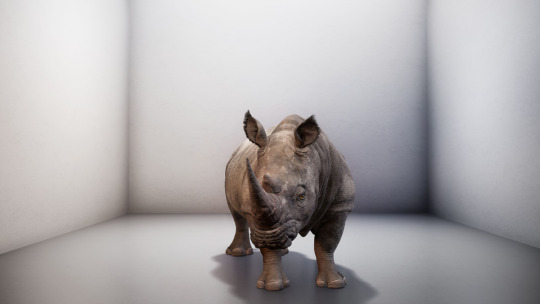
The Substitute, (2019), Video, Alexandra Daisy Ginsberg
March 20th, 2018. The date that the headlines announced the death of the last male northern white rhinoceros, Sudan. Ginsberg’s video installation explores a paradox, “our preoccupation with creating new life forms, while neglecting existing ones”. https://www.daisyginsberg.com/work/the-substitute
vimeo
In this video installation by Alexandra Daisy Ginsberg, a northern white rhinoceros is digitally brought back to life. The video starts off with three white walls, the screen seems to be the fourth wall making the room, transparent so we can view the animal, like in a zoo. Around 10 seconds into the video, a pixelated rhino begins to appear, you can hear it breathing and shuffling. The rhino moves around the room, as if adjusting to its new virtual habitat, it moves from pixilation to lifelike. Although this is completely artificial, the rhino looks and sounds real, “the behaviours and sounds are adapted from rare research footage of the last herd, provided by Dr Richard Policht”. To this date there is said to be only 2 northern white rhinoceros’ alive, both of which are female. 11th September 2019, the date where scientists from the Avantea laboratory in Italy announced that they had successfully created 2 Northern white rhino embryos.
https://www.savetherhino.org/rhino-species/white-rhino/scientists-have-successfully-created-northern-white-rhino-embryos/
This installation is powerful, it is a reminder that we will hunt a species until they’re extinct, attempt to save them artificially, breed, capture, torment animals, and still believe we are doing good.
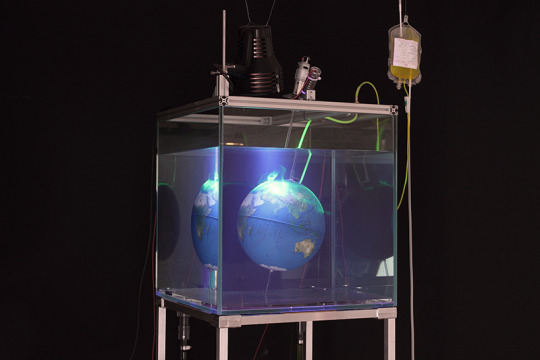
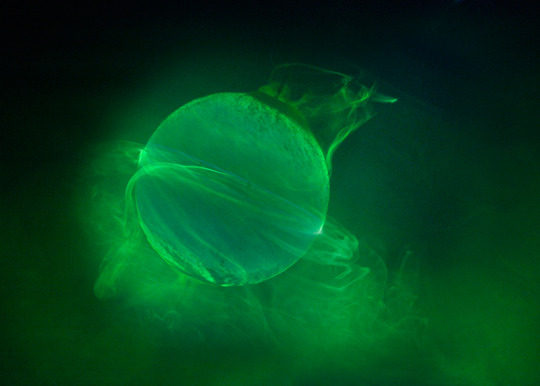
Domestic catastrophe N°3: La Planète Laboratoire, (2012), HeHe
HeHe collaborated with Dr. Jean-Marc Chomaz, Ladhyx, École Polytechnique to create this installation of an “aquarium containing a domestic globe, a motor to turn the globe and electronic valve or drip feed which releases a fluoresceine tracing dye onto the sphere. As the sphere turns, the green dye wraps itself around the sphere, enveloping it in what appears to be a thin gas or atmosphere that surrounds the planet Earth.” http://hehe.org.free.fr/hehe/planet/index.html
vimeo
This piece has a strong message behind it, forcing the viewer to stop and think about what we are doing to the Earth, if all the intoxication, climate change, pollution, emissions, etc. was visible, this is how the world would look. As the globe spins continuously on its axis, the green mist covers it, HeHe is showing us the devastating effects we are causing to planet Earth. “Domestic catastrophe Nº3: La Planète Laboratoire is both peaceful and disturbing in its evocation of a fluid smothering”. https://cargocollective.com/curatingthecosmos/HeHe-Domestic-Catastrophe-N-3-La-Planete-Laboratoire
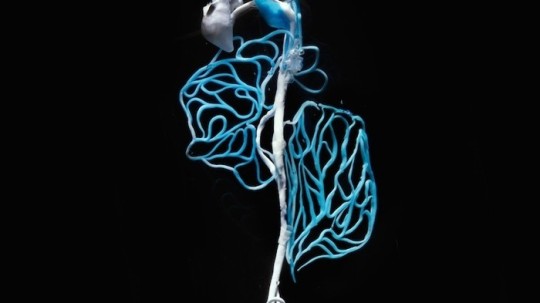
Plastoceptor and Stomaximus, (2014), Pinar Yoldas
Turkish artist, Pinar Yoldas created the installation Plastoceptor and Stomaximus in response to her intrusive daydreams, she dreams of the Pacific Trash Vortex. Imagining the organic forms evolved to eat plastic that might grow from the plastic particulate that floats in the Pacific Ocean. “If life started today in our plastic debris filled oceans, what kinds of life forms would emerge out of this contemporary primordial ooze??”
https://books.google.co.uk/books?id=wa-SDwAAQBAJ&pg=PA13&lpg=PA13&dq=If+life+started+today+in+our+plastic+debris+filled+oceans,+what+kinds+of+life+forms+would+emerge+out+of+this+contemporary+primordial+ooze?&source=bl&ots=sD-jNs4D8I&sig=ACfU3U0D6Oy6tFkXtBcr6L5twJkhEOS0hA&hl=en&sa=X&ved=2ahUKEwiwkYPTtr3pAhXIEcAKHQxvCqEQ6AEwAXoECAoQAQ#v=onepage&q=If%20life%20started%20today%20in%20our%20plastic%20debris%20filled%20oceans%2C%20what%20kinds%20of%20life%20forms%20would%20emerge%20out%20of%20this%20contemporary%20primordial%20ooze%3F&f=false
0 notes
Text
Creating Video/GiFs
18/02/2020
Today I started experimenting with Premiere Pro and Creating GiFs from https://giphy.com/
I have used links from Youtube and Video recording that I already had.
I’ve imported them into Premiere Pro and choose an input and output of the scene I needed and then export them into an H264 format which is the heavier compression for the internet ( Thankfully I had 4 pages of notes, which explained how to do all of this, from the PremeierePro workshop with Georgie last semester!!!)

After I uploaded them into https://giphy.com/ and choose the duration of the GiF ( I am surprised to see how easy it is to do!)

And I then saved the GiFs into my account (privately) and export them into MP4 format and re-opened them with PremierePro to create a video. I started mixing videos taken by me of people’s reactions, body parts, movements, and expressions with video taken from Youtube of journalist discussion climate change, Greta Thunberg, Corona Virus news, Brexit celebrations etc..



ALSO, I did a few pieces of research on installation with mirrors and went to the ECO-Visionaries exhibitions at the Royal Academy of Arts ( https://www.royalacademy.org.uk/exhibition/architecture-environment-eco-visionaries ) which was extremely interesting and inspiring as well as awakening to see how other artists and designers are responding today to some of the most urgent environmental and ecological issues.
My favorite was the win > < win by Rimini Protokoll (Helgard Kim Haug / Stefan Kaegi / Daniel Wetzel)( Image below )

It is a multimedia immersive installation that invites the viewer on a journey through time that may seem so real it will be impossible to forget. In the future, we will encounter creatures that emerged on our planet 670 million years ago and will continue to survive when many other species have vanished from the face of the Earth. The name of the project refers to the win-win principle, which allows both sides in interaction to benefit from it without the other side losing. But if these amazing ancient creatures are destined to win as a result of human impact on the planet, what guarantees are there that we will survive? (source https://garagemca.org/en/exhibition/the-coming-world-ecology-as-the-new-politics-2030-2100/tour/rimini-protokoll )
You are sitting in front of this mirror where you see yourself and the people sitting next to you while wearing headphones. A voice starts talking about jelly fishes, ocean and global warming . Then when the light goes off, the mirror becomes a jellyfish tank. You are there staring at these beautiful creatures floating and swimming while listening to the voice in the headphones. Suddenly the fishtanks becomes transparent and you see people sitting on the other side of the tank, in a different room but they don’t see you. The voice on the headphones tell You to wave them goodbye and leave a message typing with your fingers. It was incredible...
0 notes
Link
Seeing the perception of different lives and following their footsteps was really interesting to watch.
notes and ideas:
“situation rooms” - From this idea: I could film a routine of mine or someone else and get another person to follow it or follow differently in their own environment, using the similar idea from before and project the comparing lives onto a building.
0 notes
Text
Spring comes to Utrecht

SPRING 2019 sees New technology and humanity in Utrecht when for ten days, the city is the stage for radical, contemporary, international performing arts We welcome amongst others Kris Verdonck & ICK, Mette Ingvartsen, Boris Charmatz, Stefan Kaegi | Rimini Protokoll, Naomi Velissariou | Theater Utrecht, Dries Verhoeven Opening SPRING 2019 will be renowned Australian dance companies Dancenorth and Lucy Guerin Inc with Indonesian musical duo Senyawa The seventh edition of SPRING Performing Arts Festival is about new technology and humanity. Stefan Kaegi | Rimini Protokoll, Dries Verhoeven and Kris Verdonck & ICK are working on new technology. Daniel Kok & Luke George, Naomi Velissariou | Theater Utrecht and Vincent Riebeek take a closer look at the human body. Fang Yun Lo, Shira Eviatar and Zora Snake investigate cultural identity in the globalized world. SPRING takes over the public space of Utrecht with Jeroen van Loon and Andrea Božić & Julia Willms | TILT. SPRING Performing Arts Festival takes place from Thursday 16 to Saturday 25 May 2019 in various theatres and public spaces in Utrecht. For ten days the audience will be introduced to bold, contemporary international performing arts. The full programme is: now known. SPRING opens on Thursday 16 May with Attractor from Dancenorth, Lucy Guerin Inc, Gideon Obarzanek and Senyawa. In Attractor, two renowned Australian dance companies Dancenorth and Lucy Guerin Iink together with the energetic Indonesian musical duo Senyawa who combine traditional Indonesian music, heavy metal singing, virtuoso dancers and the audience. This performance is an ode to the power of music and dance. High Tech: Performing Technology Within the High Tech: Performing Technology programme, SPRING presents a number of amazing performances and installations with robots, humanoids and machines as performers. With inflatable objects, machines and real people, the premiere SOMETHING (out of nothing) by Kris Verdonck & ICK asks the question, what place people occupy in a world that is increasingly driven by the dominance of technology? Stefan Kaegi from Rimini Protokoll created a human-like robot from Thomas Melle for Uncanny Valley. In a monologue, the robot asks what happens when a person is copied. With the installation Happiness, Dries Verhoeven explores the world of artificial happiness that increasingly presents itself in the form of drugs and other drugs. Angela Goh examines gender, technology, intimacy and power from a female perspective. Super Human: Performing Humanity Humanity is shown in the Super Human: Performing Humanity program line. With 10,000 gestures as an anti-museum, the French choreographer Boris Charmatz wants to create a human database in response to our digital databases. The Greek choreographer Tzeni Argyriou shows in ANΩNYMO how traditional dance can play a role in creating community before the rise of social media. In the theatrical concert performance PERMANENT DESTRUCTION: The HM concert, Naomi Velissariou | Theater Utrecht finish with the taboos from the current visual culture. Daniel Kok & Luke George connect the public with sailor knots and fluorine ropes and unravel the limits of collective responsibility, sex and power. Global Affairs: Performing Politics The Global Affairs: Performing Politics programme line takes us across the world to Iran, Taiwan, Nauru and Cameroon. In Utrecht's public space, the Cameroonian artist Zora Snake literally exposes himself in Transfrontalier to the hopes, pains and obstacles that characterize the refugee trail. In Through the Skin, young Iranian choreographers Mitra Ziaee Kia & Hiva Sedaghat portray their personal experiences with love through their bodies - and all the pleasure and pain associated with it. Urban Affairs: Performing the City Under the name Urban Affairs: Performing the City, SPRING takes possession of the city again. Polygon by Lawrence Malstaf forms a geometric landscape that changes shape at unexpected moments. Ephemeral Data by Jeroen van Loon is a ten-day performance in which sand creates an enormous transient Google Maps visualization of the city of Utrecht. Ticket sales for SPRING Performing Arts Festival start on 28 March via springutrecht.nl. In total, the festival presents 21 productions and 83 performances. The festival lasts from 16 to 25 May 2019. Read the full article
0 notes